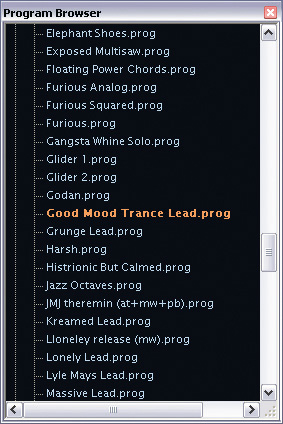MusicRadar Verdict
Best-known for their sequencers, Cakewalk are fast becoming first-rate synth developers too. Rapture absolutely rocks!
Pros
- +
Great sounds. Mucho modulation. SFZ import option. Lots of good musical presets. Tons of filter modes. Lightening-fast envelopes.
Cons
- -
Difficult to recreate some classic wavetable sounds.
MusicRadar's got your back

CMU99.rev_rapture.grab_1.jpg

CMU99.rev_rapture.patch.jpg
Hot on the heels of their Dimension Pro ROMpler, Cakewalk have released another cross-platform synth in the shape of Rapture. To create this, the company once again utilised the considerable skills of rgc:audio's Rene Ceballos.
The result is an instrument that contains a slick, inspirational feature set wrapped up in an intuitive and inviting interface.
Riding the waves
Aimed at contemporary pop, dance and electronic musicians, Rapture is offered as an AU, VST, RTAS and DX plug-in instrument and will set you back £149. From the outset, its heritage is clear; the design is similar to that of rgc:audio's much-loved Z3TA+, although Rapture's smoky grey look is rather different to the burnished metal interface of its sibling.
What's more, where Z3TA+ derives its power from waveshaping, Rapture draws upon more traditional wavetable synthesis to create its sounds.
So it's a ROMpler then? Well, yes. And no. Unlike Dimension Pro, Rapture does not come bundled with gigabytes-worth of sampled instruments. As such, it's unlikely to be your first choice if you want to create sublime orchestral scores.
Like many of the popular hardware instruments of the 80s and 90s, Rapture calls upon a relatively small assortment of samples, and these are used as fodder for the synthesis engine. The focus is on all things synthetic, although you will find a few string and guitar patches onboard.
Just over two hundred samples come included, and these can be loaded into any of Rapture's six oscillators. Most of the samples are taken from various synthesizers, both hard and soft (we noted some Oberheim waves as well as some stuff from Z3TA+).
Want all the hottest music and gear news, reviews, deals, features and more, direct to your inbox? Sign up here.
This may seem a rather meagre selection of waveforms if you're accustomed to using the vast volumes of samples that come included with many of today's ROMplers. But it's pertinent to recall that the classic Ensoniq ESQ-1 came with a mere 30 or so samples, and some people are happily squeezing new timbres out of it some 20 years after it was first issued.
A quick stroll through Rapture's 500-odd preset patches reveals that its 200 waves offer no shortage of possibilities, and if you do decide that you need more samples, you always have the option of importing SFZ-formatted waves.
The heart in Rapture
Rapture's architecture is loosely similar to a number of PCM hardware synthesizers of the past. It sports six non-aliasing oscillators, each of which has a dedicated pair of multi-mode filters in tow.
And when we say multi-mode, we're not kidding; there are 16 filter modes from which to choose, including all the expected low-, high- and band-pass varieties. The filters sound highly convincing, with little of the exaggerated low-end resonance that we've often heard in other virtual analogues.
The filters, oscillators and such like spring vibrantly to life when you start messing around with the considerable number of modulation sources on offer. There are no less than 40 envelope generators, LFOs and step generators, plus a generous selection of MIDI Continuous Controllers.
These can be routed to a multitude of destinations via the pop-up modulation matrix. There is also an X-Y pad for further control of assignable parameters.
The envelopes, LFOs and step modulators are all accessed from a large display that sits slap bang in the middle of the GUI. We're pleased to be able to report that in addition to the usual filter cut-off, amplitude and pan destinations, there are also dedicated envelopes, LFOs and step generators for the resonance settings. This is a useful but often overlooked mod source that can add some real interest to your patches.
Finally, your Rapture patch can be completed with three global multi-effects processors. All the standard stuff is available, including chorus, delay and EQ. Each of the six individual elements has its own effects too.
Rapture's delight
In truth, we are extremely impressed with Rapture. This instrument harks back to the lush sounds of classic hardware PCM units such as the Roland JD-800 and the Ensoniq VFX. Pleasingly, Rapture can also be aggressive and biting - the envelopes are extremely snappy and are capable of making a real impact.
Rapture is a great tool for anyone who makes synth-based music. It offers some refreshingly (and unashamedly) digital tones, and can spit out sounds that are suitable for genres ranging from trance and industrial to new age and new wave.
While it lacks the harsh digital grunge of a PPG or Microwave, Rapture certainly sounds a bit edgier than, say, a DX7, and let's not forget that it can serve as a virtual analogue of no small ability as well. This is a damn fine synth, make no mistake, and we recommend it wholeheartedly.
Computer Music magazine is the world’s best selling publication dedicated solely to making great music with your Mac or PC computer. Each issue it brings its lucky readers the best in cutting-edge tutorials, need-to-know, expert software reviews and even all the tools you actually need to make great music today, courtesy of our legendary CM Plugin Suite.
